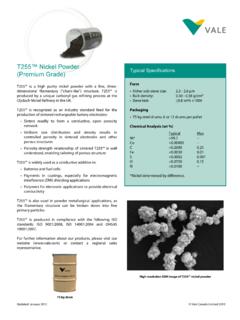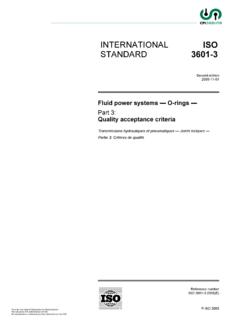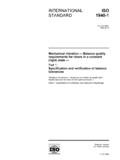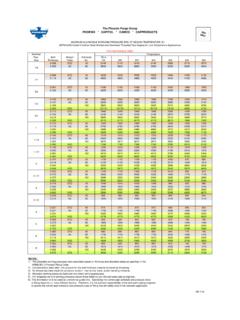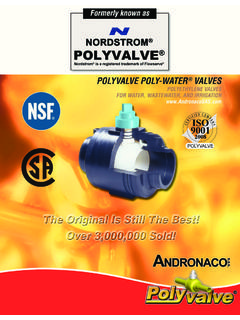Transcription of Evaluation of ISO Method in Saffron Qualification
1 Evaluation of ISO Method in Saffron Qualification F. Hadizadeh , M. Mahdavi, Emami, Z. Khashayarmanesh, M. Hassanzadeh, J. AsiliSchool of PharmacyMashhad University of Medical Sci. MashhadIranM. Seifi, H. NassirliBiotechnology & Pharmaceutical Sciences Research CenterMashhad University of Medical Sci. MashhadIranA. ShariatimoghadamR. NoorbakhshNovin 91735-1356 MashhadIranStandard InstituteMashhadIranKeywords: crocin, HPLC, ISO, picrocrocin, safranalAbstractThe factors which are very important in Saffron are crocin (color), picrocrocin (flavor) and safranal (aroma). Higher amount of these compounds in Saffron provide higher quality of Saffron . ISO (the international organization for standardization) has set a classification of Saffron based on minimum requirements of each quality. According to ISO picrocrocin, safranal and crocin are expressed as direct reading of the absorbance of 1 % aqueous solution of dried Saffron at 257, 330 and 440 nm respectively.
2 There was some doubt about the accuracy of the safranal result using ISO Method . Therefore it was decided to evaluate the amounts of safranal and crocin in Saffron according to ISO Method and compare the results with the amounts of these compounds when using high performance liquid chromatography (HPLC). In HPLC Method in an isocratic run a 30 cm ODS column were used. Mobile phase was mixture of acetonitrile and water (76 % v/v). A UV detector at wavelengths of 308nm for safranal and 440 nm for crocin was also employed. Results indicated that standard crocin had significant absorption at 308nm. We concluded that present ISO Method is not an accurate Method to measure the amount of safranal in Saffron . Therefore it is suggested to evaluate this Method and meanwhile using a HPLC Method to evaluate the amount of safranal and crocin in Saffron is a food spice obtained from the flower stigmas of Crocus sativus L.
3 , a member of the Iridaceae family. It plays an important role in the culinary culture of different regions of the world, where it is used as a food additive, since it possesses powerful coloring and flavoring properties due to its glycosidic constituents (Caballero-Ortega et al., 2004 ; R os et al., 1996;). The most important compounds in Saffron are crocin , picocrocin and safranal (Fig. 1), responsible for Saffron color , flavor and aroma respectively (Fern ndez, 2004) (Fig. 1). The amounts of these main compounds are used to express the quality of Saffron (Tarvand, 2005). The higher the amounts of these compounds in Saffron , means higher quality of Saffron . ISO (the international organization for standardization) is a worldwide federation of national standard bodies (ISO member bodies), they have set a classification of Saffron based on minimum requirements of each quality, and this is called ISO 3632.
4 According to this classification, they established 4 categories (Table 1). Saffron with the best quality belongs to category I, which means direct reading of the absorbance at about 440nm for crocin is grater than 190. (Tarvand, 2005). Safranal is the compound mainly responsible for the aroma of Saffron spice and can be used as a measure of Saffron quality. Saffron samples are evaluated by a safranal value by means of a spectrophotometric Method based on ISO 3632 (ISO, 1993, ISIRI). Safranal value is expressed as direct reading of the absorbance at about 330 nm (Alonso, 2001). On the other hand color strength of Saffron which is related to crocin is expressed as direct reading at 400 nm according to ISO 3632 (ISO, 1993, ISIRI).It has been previously reported that crocins have absorption at 257 and 330nm (cis-crocin) in addition to their main peak at around 440nm (Alonso, et al., 1998; Tarantilis, et al.)
5 , 1994). So, expression of safranal and picrocrocin value as direct measurement at 257 and 330 nm according to ISO may be misleading and should be revised (Trantillis et al., 1995; Alonso et al., 2001). In addition solubility of Saffron constituents in water is not perfect. Therefore, it was decided to evaluate the amounts of safranal and crocin in Saffron stigmata from different cities in Iran, with UV spectrophotometer and compare the results with the amounts of these compounds when using high performance liquid chromatography (HPLC). In this research the effects of extraction with ethanol 50 % (v/v) and sonication rather than usual shaking examined as well as standard ISO 3632 extraction AND METHODSS ource of Saffron and ReagentsAuthentic samples of safranal and crocin were obtained from Fluka (Cat No. 17306 & 17304). Saffron samples were obtained from different cities of Khorasan province, including Torbat-Heidarieh, Sabzevar, Kashmar, Mashhad and Neishapoor.
6 Samples were dried in an oven at 60 C with dry silica gel until constant weight (percent humidity calculated). After grinding, the samples were passed through a mm mesh and stored in the dark at 4 C until they were used. The methanol and acetronitrile used were purchased from Merck. All of the reagents were of HPLC procedureA 100 mg mass of dry stigmata was extracted with 5ml of cold 50 % (v/v) ethanol in a pestle and mortar, it was then transferred to a screw-capped vial and a total volume of 20ml 50 % (v/v) ethanol was added to it. Vials were sonicated for 20 min and then centrifuged at 4000 rpm for 10 min and washed twice with 5ml each of the same solvent. The supernatant was used for analysis by spectrophotometric procedures. An extraction procedure with cold water according to ISO 3632 was also supernatant (1ml) was diluted to 5ml with 80 % (v/v) ethanol for analysis using a Shimadzu (Tokyo, Japan) UV 160 A, UV-visible recording spectrophotometer.
7 The absorption maxima for authentic crocin and safranal were 443 and 308 nm respectively as it has been reported previously (Sujata et al., 1992). A standard curve was prepared by measuring the absorption of crocin at 443 nm. Sample Preparation and Chromatographic ConditionsTo separate crocin and safranal and measure amounts of those in a Saffron extraction a slightly modified published Method was used (Sujata et. al., 1992). The extract of authentic stigmata in 80 % (v/v) ethanol was passed through a m Millipore filter (Millipore, Bedford, MA, ) and eluted with 100 % acetonitrile. A Shimadzu HPLC LC-10 ADvp system integrated with a Shimadzu SCL-10 Avp system controller and a SPD-10 Avp UV-visible spectrophotometric detector was used for the analysis of the all compounds. A Shimadzu 25cm x mm Shim-pack VP-ODS column with a nm pore size and m particle size was used for the separation and identification of compounds.
8 A Rheodyne Shimadzu Model 7725i injector was used to inject 20 l of the sample from a 25 l Hamilton straight-edge needle syringe onto the column. All data were recorded and analyzed on chromatography workstation Shimadzu Class-VPTM software. Crocin ( max= 443) and safranal ( max= 308) were separated on an isocratic run with mobile phase consist of 76 % acetonitrile in water at a flow rate of ml/min. In crocin chromatograms a peak at 308 (( max of safranal) was also appeared. RESULTS AND DISCUSSIONThe amount of crocin content of Saffron which has been reported previously is 29 mg/g (Li et al., 1999), mg/g (Caballero-Ortega et al., 2004) for Iranian Saffron and mg/g (Sujata et al., 1992) for Indian samples. All direct reading E1% of extracted Saffron of samples in distilled water at 440 nm were above 190. This indicates all the Saffron samples belong to category I according to ISO classification (see Table 1).)
9 Amounts of crocin in the analyzed Saffron samples were fairly close when they were analyzed either by HPLC or UV-Visible spectrophotometry. As it has been reported previously (Sujata et al., 1992) there was a good correlation between the crocin results obtained from the two different methods (Table 2). The extraction Method of crocin according to ISO 3632 was modified in order to improve the extraction procedure. In this modification instead of pure distilled water for extraction, mixture of distilled water and ethanol (50:50) was used. Also sonication was also used to increase the yield of extraction of safranal and crocins. Crocin content of one of the Saffron samples (Mashhad sample) extracted using classical ISO Method and modified procedure were and mg/g respectively when measured by UV-Visible spectrophotometry. The amount of crocins measured by HPLC for the same sample was found to be mg/g (Table 2).
10 The amounts of safranal in this sample were also increased when UV-Visible spectrophotometry and modified extraction procedure were used. They were and mg/g for classical ISO Method and modified procedure respectively. As previously mentioned crocin has absorption at safranal absorption maxima ( max = 330) , therefore, the results of measuring safranal by UV-Visible spectrophotometry shows higher than the real amount in the Saffron sample (Alonso et al., 1998; Tarantilis et al., 1994). For Mashhad Saffron sample, safranal content was The amount of safranal in the same sample Saffron sample was mg/g when measured by HPLC. Direct reading of this sample at 330 nm was which is between 20 -50 accordingly. As it has been indicated by others (Alonso et al., 2001) these results also shows that the direct reading of safranal at 330 nm which is a criteria for safranal content (according to ISO 3632) can not be reliable.

